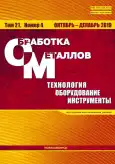Introduction. Metallic glasses are of interest to researchers as materials that can be used as protective coatings for metals and alloys. The study of new methods for forming coatings made of metallic glass is an urgent task. Purpose: to study the conditions of formation and properties of metallic glass coatings obtained by the method of electrospark treatment of steel 1035 in a mixture of iron granules and a multicomponent powder mixture consisting of chromium, tungsten, molybdenum, silicon, boron and carbon. Methods. The powder mixture had an average particle size of 0,3 μm. The volume fraction of the powder in the mixture with granules varied from 2,5 to 9,3 vol. %. Coatings are deposited at pulse energy of 0,33 J with a frequency of 1 kHz for 8 minutes in argon. The composition and structure of the coatings are studied by X-ray diffraction analysis, scanning microscopy, and energy dispersive analysis. Results and discussion. The average thickness of the coatings is in a narrow range of 41…43 microns. The proportion of the amorphous phase in the coatings ranges from 78 to 95 vol. %. The distribution of elements over the coating cross section is uniform. With increasing powder content in the mixture of granules, the iron concentration in the coatings decreases from 60 to 41 at. %. In this case, the ratio of the remaining elements in the composition of the coatings corresponds to the composition of the multicomponent powder, which indicates the uniform participation of powder particles of different grades in the formation of the deposited coatings. The wear rate of samples with coatings in the dry sliding mode is in the range 0,7…5,9 × 10–5 mm3/Nm, which is 2,5…6,5 times lower than that of steel 1035 without coating. The cyclic corrosion resistance of samples with coatings at a temperature of 700 °C for 100 hours of testing is 15…30 times higher than that of steel 1035, which is explained, first of all, by the presence of chromium and silicon in the coatings.
 6-18
6-18


 19-30
19-30


 31-46
31-46


 47-58
47-58


 59-69
59-69


 70-84
70-84


 85-93
85-93


 94-112
94-112


 113-126
113-126







